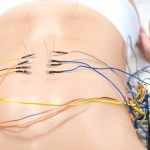glucose
When blood sugar concentrations are elevated, humans run the risk of glucose binding to proteins in the blood and causing the irreversible formation of advanced glycation end products (AGE). Once formed, AGEs can bind to their receptor (RAGE) and stimulate inflammation and oxidative stress. This pathological signaling can be stopped by pieces of the RAGE protein that break off and form a soluble version called sRAGE. These soluble versions of RAGE are good because they can bind excess AGEs and prevent their effects.
A new study published in the American Journal of…
Dr. Clara do Amaral is a postdoctoral fellow at the University of Dayton in Ohio where she studies freeze tolerance in frogs. She received a Research Recognition Award from the Comparative and Evolutionary Physiology section of the American Physiological Society at the 2017 Experimental Biology meeting in Chicago, IL. She prepared this award-winning guest blog entry to describe her interesting research:
The Cope’s gray treefrog is a small frog that occurs in the eastern United States. You can find it sitting on the trunks and branches of trees, and you can hear it calling from the…
"Branta canadensis 4014" by Dori - Own work. Licensed under CC BY-SA 3.0 us via Wikimedia Commons - https://commons.wikimedia.org/wiki/File:Branta_canadensis_4014.jpg#/med…
A study published earlier this month examined how Canada geese (Branta canadensis), long-distance migratory birds, regulate their blood sugar levels during prolonged fasting. Dr. Jean-Michel Weber and Eric Vaillancourt (University of Ottawa, Ontario, Canada) were interested in understanding whether the pancreatic hormone glucagon could alter blood sugar in the birds. In mammals, glucagon maintains…
Canadian Geese. Image take near Lakeview, OR. Image from: Bureau of Land Management
A new study conducted by researchers Eric Vaillancourt and Jean-Michel Weber at the University of Ottawa examined blood sugar regulation in a bird that specialize in long distance migration, the Canada goose (Branta canadensis, image above). As referenced in the study published in the American Journal of Physiology - Regulatory, Integrative and Comparative Physiology, Canadian geese migrate approximately 7,000 km on their way to the Arctic, a trip that includes non-stop flights of up to…
Image of electroacupuncture to the back from www.sandiegohealingarts.com
A new study published in AJP-Regulatory, Integrative and Comparative Physiology suggests that electroacupuncture to the abdominal region may prevent increases in blood sugar concentrations after a meal by affecting insulin sensitivity and circulating free fatty acid concentrations. Granted this is not comparative physiology research, I find it interesting that electrical stimulation can have such a large impact on metabolism, in mice at least.
Drs. Nicola Abate and Jiande Chen, lead investigators…
Image by He Meng, from Nature News
Bactrian camels thrive in conditions considered harsh by many standards: very dry, cold, high elevations. Researchers now suspect their physiological adaptations of high blood sugar, high salt diets, and increased body fat may have evolved to help the animals cope with their environment. For humans, those symptoms could lead to heart disease, but for the Bactrian camel, they are considered physiological, i.e. totally normal.
A paper published in Nature Communications describes the genomic variations in wild and domesticated Bactrian camels. What they…
I've written before (here and here) about some of the research that's been demonstrating the importance of avoiding long stretches of sedentary time. (The Sedentary Behavior Research Network has proposed that "sedentary" refer to waking time spent sitting or lying down and expending little energy, while "inactive" refer to people with low levels of overall activity, and I'm using those definitions.) Some of us may feel virtuous for meeting CDC's physical activity guidelines through regular workout sessions, but bouts of aerobic exercise can't completely offset the toll of too much time spent…


